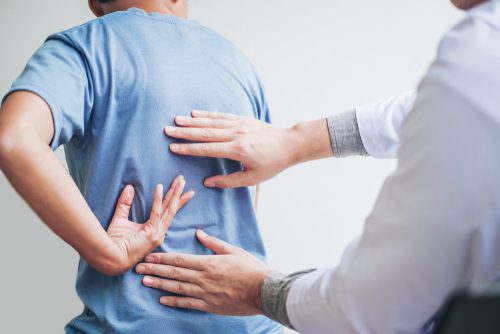Low back pain is a very common complaint that accounts for around 2 million episodes per year. Annual prevalence between 15-45% of the population. In one study, it was the most common type of pain reported by patients, with 25% of U.S. adults reporting low back pain (or LBP) in the prior 3 months.

Oftentimes the source of back pain or discomfort originates from the structures of the spine or surrounding muscles. This includes the bones of the spine, the shock-absorbing discs, the joints, the nerves, the connective tissue or supporting musculature. Examples are Herniated Discs, Bertolotti Syndrome, Sciatica, and Inflamed Facet Joints. Pain from these structures is typically what we will see and treat in our clinic, but there are several other problems that can masquerade as spine pain. Below is a partial list with associated symptoms that we must be aware of to ensure that patients are getting the most appropriate treatment.
What Else Might Be Causing Your Back Pain
Kidney Stones
The most common symptom is severe pain, usually in the side of the abdomen, that’s often associated with nausea. There can also be blood in the urine.
Cancer
Tumors arising in the prostate, lung, colon, skin and spine can all cause direct, or referred pain to the spine. Certain blood cancers can also cause spine pain. Cancer pain typically starts gradually and worsens over time. Pain does not improve with rest and may intensify at night. Patients may also have night sweats, fever, and weight loss.
Organs
- Pancreas-people describe this pain as a dull pain that feels as if it is boring into you. It can begin in the stomach area and spread around to the back. The pain is worse when you lie down and is better if you sit forward.
- Ovarian/uterus-pain can have relationship to menstrual cycles. In some cases, ovarian cysts can trigger dull and aching lower back pain. Rarely, fibroids press against the muscles and nerves of the lower back and cause back pain. A large fibroid on the back surface of the uterus is more likely to cause back pain than a small fibroid within the uterine wall.
- Prostate-prostatitis can produce uncomfortable symptoms such as burning during urination, a frequent need to urinate, and pain in the lower back
- Gallbladder– Pain can be sudden and rapidly intensifying pain in the upper right portion of your abdomen. Back pain between your shoulder blades.
- Stomach-pain from a gastric ulcer can be related to eating. Signs of digestive distress often include pains in your abdomen or reactions that include vomiting or diarrhea. Depending on the condition, however, you could feel pain in your back as well. A peptic ulcer can cause referred pain in your back.
Infection
- Shingles, UTI, tuberculosis are all examples of infections that can cause back pain.
- A bladder infection may cause pelvic pain, increased urge to urinate, pain with urination, and blood in the urine. A kidney infection may cause back pain, nausea, vomiting, and fever.
- Shingles causes a painful rash that may appear as a stripe of blisters on the trunk of the body. Pain can persist even after the rash is gone (this is called postherpetic neuralgia).
Vascular
An abdominal aneurysm (AAA) can cause sudden intense pain that is felt in the lower back which can be described as a tearing sensation. Patients may have low blood pressure and a fast pulse.
Find the Source of Your Back Pain

So, there are many different potential causes of low back pain beyond the typical pain generators in the spine. It is very important for patients to have a thorough evaluation by a medical provider who is an expert at deciphering the cause of pain. This includes taking a good history with attention to symptoms and other associated medical conditions. The provider must be able to order and interpret test results and perform a comprehensive medical examination. This will allow for a specific treatment plan that will give specific results.

Board-Certified Physical Medicine & Rehabilitation by ABPMR and AOBPMR
Fellowship-Trained and Board-Certified in Pain and Musculoskeletal Medicine



